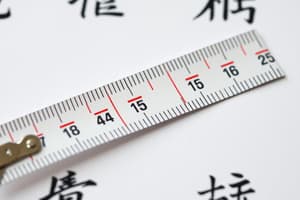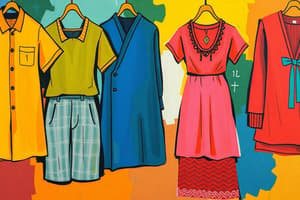Podcast
Questions and Answers
Describe the average Chinese person.
Describe the average Chinese person.
Slanted/almond-shaped eyes, triangular cheeks, black hair/eyes, and a skin tone that is perceived as yellowish by Westerners.
How were the northern Chinese different?
How were the northern Chinese different?
Northern Chinese tend to have a longer face with smaller eyes, slimmer nose, brighter skin tone, and flatter cheeks.
What did clothing symbolize in ancient China?
What did clothing symbolize in ancient China?
Status and profession.
Poor people made their clothes out of?
Poor people made their clothes out of?
The rich made their clothes out of?
The rich made their clothes out of?
When was white worn?
When was white worn?
When was red worn?
When was red worn?
During the Sui Dynasty, the poor could only wear __________.
During the Sui Dynasty, the poor could only wear __________.
During the Sui Dynasty, only the emperor could wear?
During the Sui Dynasty, only the emperor could wear?
Why was cotton popular with the poor?
Why was cotton popular with the poor?
Men's tunics reached their ___ while women's reached the ___.
Men's tunics reached their ___ while women's reached the ___.
Why were sashes worn?
Why were sashes worn?
What shade of clothing did the common Chinese wear?
What shade of clothing did the common Chinese wear?
What was the original Chinese clothing called?
What was the original Chinese clothing called?
What are the 3 variations of the Hanfu?
What are the 3 variations of the Hanfu?
Describe the Pien-fu.
Describe the Pien-fu.
Describe the Ch'ang P'ao.
Describe the Ch'ang P'ao.
Describe the Shenyi.
Describe the Shenyi.
What were the cuffs called?
What were the cuffs called?
What was the knee-length skirt called?
What was the knee-length skirt called?
A long piece of fabric that reached the knees is called a?
A long piece of fabric that reached the knees is called a?
How did higher ranks have an effect on clothes?
How did higher ranks have an effect on clothes?
What variation of the Hanfu became mostly worn by males?
What variation of the Hanfu became mostly worn by males?
What two colors belonged to the emperor?
What two colors belonged to the emperor?
What is the Qipau?
What is the Qipau?
Flashcards
Chinese Physical Appearance
Chinese Physical Appearance
The average Chinese person often has almond-shaped eyes, triangular cheeks, black hair and eyes, and a yellowish skin tone.
Northern Chinese Appearance
Northern Chinese Appearance
Northern Chinese individuals tend to have longer faces, smaller eyes, slimmer noses, brighter skin, and flatter cheeks.
Clothing Symbolism in Ancient China
Clothing Symbolism in Ancient China
In ancient China, clothing indicated a person's social status and profession.
Clothing Materials in Ancient China
Clothing Materials in Ancient China
Signup and view all the flashcards
Meaning of White Clothing
Meaning of White Clothing
Signup and view all the flashcards
Meaning of Red Clothing
Meaning of Red Clothing
Signup and view all the flashcards
Sui Dynasty Clothing Restrictions
Sui Dynasty Clothing Restrictions
Signup and view all the flashcards
Imperial Sui Dynasty Color
Imperial Sui Dynasty Color
Signup and view all the flashcards
Sui Dynasty Fabric
Sui Dynasty Fabric
Signup and view all the flashcards
Traditional Chinese Garments
Traditional Chinese Garments
Signup and view all the flashcards
Purpose of Sashes
Purpose of Sashes
Signup and view all the flashcards
Common Chinese Clothing
Common Chinese Clothing
Signup and view all the flashcards
Han Chinese Clothing
Han Chinese Clothing
Signup and view all the flashcards
Hanfu Variations
Hanfu Variations
Signup and view all the flashcards
Pien-fu
Pien-fu
Signup and view all the flashcards
Ch'ang P'ao
Ch'ang P'ao
Signup and view all the flashcards
Shenyi
Shenyi
Signup and view all the flashcards
Cuffs in Hanfu
Cuffs in Hanfu
Signup and view all the flashcards
Knee-length Skirt in Hanfu
Knee-length Skirt in Hanfu
Signup and view all the flashcards
Long Fabric in Hanfu
Long Fabric in Hanfu
Signup and view all the flashcards
Clothing Rank Indicator
Clothing Rank Indicator
Signup and view all the flashcards
Shenyi Gender
Shenyi Gender
Signup and view all the flashcards
Imperial Colors
Imperial Colors
Signup and view all the flashcards
Qipao Description
Qipao Description
Signup and view all the flashcards
Study Notes
Physical Appearance of Chinese People
- Average Chinese individuals often have slanted or almond-shaped eyes, triangular cheeks, black hair and eyes, and a skin tone viewed as yellowish by Westerners.
- Northern Chinese individuals typically have longer faces, smaller eyes, slimmer noses, brighter skin tones, and flatter cheeks.
Clothing Symbols in Ancient China
- Clothing in ancient China symbolized a person's status and profession.
- Poor people commonly made their clothes from hemp or ramie, while the wealthy preferred silk.
Color Significance in Dress
- White clothing was worn during periods of mourning.
- Red clothing symbolized joy and happiness and was traditionally worn by brides at weddings.
Dress Code During the Sui Dynasty
- Poor individuals were restricted to wearing black or blue during the Sui Dynasty.
- Only the emperor was permitted to wear yellow.
- Cotton was a popular fabric among the poor due to its affordability.
Men's and Women's Garments
- Men's tunics typically reached the knees, while women's dresses extended to the ground.
- Sashes served both ornamental purposes and as fasteners to secure clothing.
General Clothing Traits
- Common Chinese individuals generally wore lighter clothing.
- Traditional attire was referred to as Han Chinese clothing.
Variations of Hanfu
- Hanfu had three major variations: Pien-fu, Ch'ang P'ao, and Shenyi.
- The Pien-fu consisted of a two-piece ceremonial outfit with a knee-length tunic and an ankle-length skirt or trousers.
- The Ch'ang P'ao was a one-piece tunic dress, reaching ankle length.
- The Shenyi was a combination of a separately cut top and trouser/skirt, designed to create a one-piece look.
Clothing Features
- Cuffs were known as "yi."
- The knee-length skirt was called "shang."
- A long piece of fabric reaching the knees was referred to as "bixi."
Influence of Rank on Attire
- Social rank affected the length of skirts, width of sleeves, and the level of ornamentation on clothing.
- The Shenyi variation of Hanfu was predominantly worn by males.
Imperial Colors and Symbols
- The emperor's colors included yellow and purple, both featuring the dragon emblem.
Qipao Description
- The Qipao is a one-piece dress characterized by two wide openings at the sides, designed to fit at the hips.
Studying That Suits You
Use AI to generate personalized quizzes and flashcards to suit your learning preferences.




